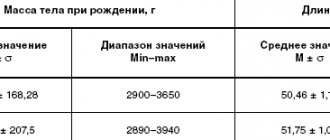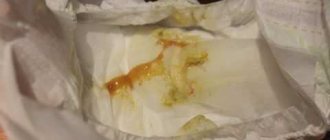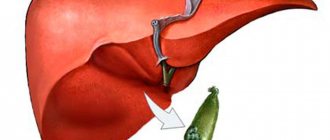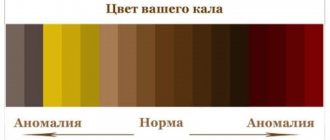The text is presented for informational purposes only. We strongly urge you not to self-medicate. When the first symptoms appear, consult a doctor. We recommend reading: “Why you can’t self-medicate?”
The appearance of mucus in a child’s stool may indicate both normal development of the baby and pathological digestive disorders. Normally, this phenomenon occurs when new complementary foods of plant origin are introduced to infants, the child overeats with insufficient fluid intake and has dense stools. Mucus also appears during infectious processes, dysbiosis and anatomical defects of the intestine.
Causes
All causes can be divided into two large groups: non-pathological (physiological) and pathological (as a result of a child’s illness).
Medical products (drugs, medicines, vitamins, dietary supplements) are mentioned for informational purposes only. We strongly do not recommend using them without a doctor's prescription. We recommend reading: “Why can’t you take medications without a doctor’s prescription?”
Non-pathological
Mucus is a normal substrate found in feces. It is necessary to facilitate the passage of feces through the intestines, reducing friction and damage to the mucous membrane by chyme. In addition, mucus has protective properties, since it contains substances that can destroy pathogenic microflora.
Nutrition
Poor nutrition can cause mucus to appear in the stool in the following cases:
- Violation of the mother's diet during breastfeeding. Any unauthorized product may cause irritation in a child's intestines in response to the unknown food.
- Late introduction of complementary foods. The baby’s intestines are sterile at birth; the enzymatic system also develops gradually, adapting to new foods and a changing diet. The appearance of mucus indicates that the child is not physiologically ready for new food; it is still necessary to wait for the pancreatic enzymes to mature and for the completion of colonization of the intestines with beneficial microflora.
- Fluid deficiency. Low water consumption leads to compaction of stool, especially if the child overeats. The intestines try to push through dense waste products. To prevent trauma to the mucous membrane, the amount of mucus increases.
- Milk. With lactase deficiency, a deficiency of an enzyme capable of processing milk fats, a baby in the first six months of life often has mucus in the stool. This is not always a pathology, it’s just that enzymes are prescribed at first until the child’s pancreas adapts.
Be sure to read:
Why does black loose stool (melena) occur?
Medicines
Medicinal substances by themselves do not increase mucus production. However, when taking some medications, it is possible to develop increased mucus secretion.
- Antibiotics . Violation of the rules for taking these medications (uncontrolled, chaotic, unmotivated) leads to the formation of dysbiosis. It is not the antibacterial drug itself that leads to an increase in mucus volumes, but its side effects.
- Stool-fixing drugs (Smecta, Activated carbon, Atoxil). In case of an overdose, mucus may appear, which is necessary to facilitate the passage of feces through the intestinal tube and the act of defecation.
Runny nose
Since the child does not yet know how to fully and correctly blow his nose in the stool, mucus can often be found in any respiratory disease. The child swallows the snot, and it passes through the entire gastrointestinal tract in transit.
It is important not to miss the manifestations of enterovirus infection, in which mucus in the stool is the result of the virus affecting the intestinal mucosa, and not just snot. The main difference is the appearance of dyspeptic manifestations in the form of flatulence, diarrhea, nausea and even vomiting.
Pathological causes
Most often, when mucus appears in a child’s stool, you should think about pathological changes and contact a pediatrician to clarify the pathology. This is especially true in cases where mucus is not the only clinical sign, but other symptoms are also present.
Inflammatory bowel pathologies
Inflammatory diseases include:
- Infectious diseases. The main cause of inflammation of the mucous membrane is the pathological effect of microorganisms on it. These can be viruses (for enteroviral diseases), and bacteria, fungi and even protozoa (for example, amoebiasis). Mucus is most often colored: in case of viral pathologies it is transparent, in case of bacterial microflora it is greenish-yellow purulent in nature, in case of fungal invasion it is white flakes, in case of amoebeasis it sometimes takes on the appearance of raspberry jelly.
- Autoimmune pathologies. Diseases such as ulcerative colitis or Crohn's disease lead to autoimmune damage to the intestinal wall by one's own cells. Defense systems do not distinguish, in this case, their tissues from the pathological substrate. This is the severity of the pathology, since for treatment it is necessary, in fact, to kill the child’s immunity.
Anatomical developmental abnormalities
Anatomical defects that can cause the appearance of mucus include:
- Dolichocolon (dolichosigma). An additional loop of intestinal segment leads to the formation of fecal congestions, which are compacted within several days and then move through the intestines with difficulty.
- Megacolon. The expansion of the intestinal ampulla leads to the accumulation of a large volume of feces in this area, which subsequently has difficulty passing further without additional shock absorption and protection of the mucous membrane with a slippery lubricant.
- Hirschsprung's disease. The absence of a nerve ganglion in a certain area of the intestine, which stimulates the work of muscle fibers and maintains their tone, leads to its expansion. In the future, only mucus helps push the feces further towards the exit.
Be sure to read:
How does dehydration manifest during diarrhea and how to treat the pathology?
Other reasons
Other pathological causes that can lead to mucus in the stool include:
- Dysbiosis. The dissociation of the balance of beneficial and pathogenic microflora towards the predominance of the latter increases the risk of developing an intestinal infection, significantly disrupts digestion and reduces the protective reactivity of the child’s entire body. So this condition has the right to be considered pathological. It leads to instability of the stool (it can be either liquid or too dense) and is often accompanied by the appearance of mucus.
- Worms. Mechanical irritation of the mucous membrane by worms leads to increased secretion of mucus, which is necessary, first of all, to protect the mucous membrane.
- Acute surgical pathologies. These include intussusception in early childhood, diverticulitis, and appendicitis. Diseases lead to mechanical damage to the mucous membrane, which becomes inflamed with increased mucus secretion.
A baby's stool is the concept of normality
What should a normal baby's stool look like? It doesn't look like an adult's chair! Moreover, the concept of normal changes depending on the age of the baby.
In the diaper of a child who is 1-3 days , the mother will find meconium - original feces. It is a viscous, tarry, black-green, odorless mass. It is sometimes difficult to wash off. Meconium is the result of the processing of amniotic fluid that entered the baby’s stomach during the prenatal period. Original feces are passed once during the first two, maximum three days after birth. Its appearance means that the newborn’s intestines are working normally and he is receiving plenty of mother’s colostrum. If meconium does not appear, this is a cause for concern!
On the 3-4th day after birth, the mother’s milk comes in and the baby’s period of adaptation to a new way of eating begins ( physiological dyspepsia ), and this is also reflected in the stool. These days, the baby's stool is not homogeneous (with lumps, mucus, liquid part), not uniform in color (from dark green particles to yellow and whitish).
Around the 5th day, the baby moves on to normal stool , and the options for breastfeeding and artificial feeding are different. The contents of a breastfed baby's diaper do not have a strong odor, and may even smell like yogurt. A repulsive smell in stool appears when there are rotting processes in the intestines, and if mother’s milk is absorbed perfectly, then there is no smell.
Normal stool in a breastfed newborn is mushy, yellow, sometimes slightly greenish, and may contain white lumps - this is a variant of the norm. The smell is sour, but not unpleasant.
The frequency of bowel movements can vary greatly . The norm will be when the baby poops after each feeding (8-10 times a day), and when the baby’s intestines are emptied once every 3-4 days. Such a rare stool, provided that it is not hard and not dense, is also a variant of the norm and indicates that mother’s milk is well absorbed. The mother does not need to take any additional manipulations.
But if the baby is capricious, strains and cries, often farts, and his stool is shaped, or green, or foamy, or streaked with blood, this is a reason to show the baby to the pediatrician.
Up to 6 weeks, most breastfeeding babies have bowel movements from 4 to 12 times a day. By two months, the frequency of stool decreases from 2-4 times a day to once every few days.
In mixed or bottle-fed babies, stools are more similar to adult ones. It is thicker, the color is shades of brown, and has a pungent odor. The normal frequency is once a day, if less often, then you need to help the baby poop.
To normalize stool, you can use the German natural complex drug Enterokind. It is indicated for use in functional intestinal disorders and flatulence in infants and young children. The drug improves intestinal motility, normalizing the secretion of digestive enzymes. Enterokind is well tolerated and approved for use in children from birth. The course of treatment with the drug is 3-6 days.
What does the color of mucus mean?
The color of the mucus indicates the nature of the process:
- Transparent slime. Most often it appears during viral inflammation, against the background of physiological causes.
- Green slime. Indicates the addition of a bacterial agent, or the passage of snot in transit through the entire gastrointestinal tract.
- White streaks of mucus. They talk about the presence of fibrin effusion and most often occur with fungal invasion (candidiasis, intestinal damage by Mycobacterium tuberculosis). Also, white streaks occur during helminthic infestation or during the healing of ulcers and erosions against the background of an autoimmune process.
- Streaks of blood. Appear when the capillary network is damaged or excessive permeability during intussusception or amoebic infection.
When should you consult a doctor?
Mothers need to carefully monitor their baby's bowel movements. This is especially true for young children who cannot clearly describe their symptoms.
If the child’s general well-being is normal and there are no additional complaints, you can watch the baby a little, change the nature of your diet, or, if you are breastfeeding, go on a strict diet yourself. If the baby’s stool does not change within a few days, you can routinely consult with a pediatrician and, if necessary, have a culture tested for dysbacteriosis or coprogram.
Be sure to read:
Dysentery: how is the disease manifested and treated?
You should definitely consult a doctor if:
- increased body temperature;
- nausea;
- vomiting;
- the appearance of pathological impurities (blood, helminths, pieces of undigested food);
- flatulence;
- change the colors of the slime to green, white or red;
- stomach ache;
- pronounced anxiety of the baby, crying;
- severe diarrhea.
All these signs may indicate a pathological origin of mucus and require quick and correct treatment.
What should a newborn's stool look like?
Green stool with mucus in a baby after birth is most often a sign of normality. His digestive system is still imperfect, many enzymes are missing, and the microflora has not formed. This is exactly the color it should be when milk is digested. Gradually, the child’s digestion will normalize, and the color of the stool will become more familiar.
During the first 3-5 days, the baby passes original feces - meconium. It is thick, viscous, dark green, almost black. This is amniotic fluid, amniotic fluid and epithelial cells that the child swallowed during intrauterine development. Gradually, the color and consistency of the stool changes. Now the baby's stool is greenish or gray. All these are signs of normality, if the child eats well, gains weight, and does not suffer from colic.
When breastfeeding, the nature and color of the stool is affected by the mother's diet. When eating vegetables and fruits of bright colors or foods with dyes, it may acquire unusual shades. Infants often have green stools, but they are usually yellow-green in color. Sometimes streaks of mucus appear in the stool. If this is not accompanied by anxiety, colic or loss of appetite, then the baby is healthy.
Attention: if in doubt, the mother should still consult a doctor; the newborn should not be given any medications without his recommendation.
Diagnosis of causes
It is necessary to differentiate physiological manifestations of mucus from pathological ones. The main hint about the origin of the symptom is additional clinical manifestations and a thorough questioning of the mother (what the child ate, whether he was sick with anything recently, whether new complementary foods were introduced, whether there are hereditary diseases).
Basic tests that may be needed to identify the underlying cause:
- Coprogram. Microscopic and biochemical examination of feces will determine additional pathological signs: undigested food, the presence of hidden blood, worm eggs.
- Bacteriological culture (tank culture). Allows you to determine the presence of the pathogen and its sensitivity to antibacterial therapy.
- Culture for dysbiosis. Reveals the degree of separation of pathological and beneficial microflora.
- X-ray of the abdominal organs. Allows you to determine intestinal obstruction, an important test in infants with signs of abdominal bloating against the background of continuous crying (intussusception).
- Blood tests. Even a clinical analysis will make it possible to determine the nature of the inflammation (bacterial - with neutrophilic leukocytosis, viral - with lymphocytic leukocytosis, eosinophilia - with an autoimmune process or helminthic infestations). Blood tests are also carried out to check for antibodies and increased levels of autoimmune factors.
Children's Clinic Khimki
The birth of a baby is a great miracle and happiness for every family. However, during this period, parents are faced with a large number of issues in raising and maintaining health.
Not all changes indicate the presence of serious diseases. White lumps in a baby's stool can greatly frighten parents. Is this really a reason to worry and what state of stool can be considered normal.
Each child is unique, so after birth, the gastrointestinal tract continues the process of formation. This takes varying periods of time. In some cases, it takes several years for the digestive system to begin functioning properly.
It has been scientifically established that only an eight-year-old child’s stomach and intestines function like those of an adult. Until this time, you need to be extremely careful in choosing your diet.
Otherwise, the risk of various eating disorders increases. White lumps in a baby's stool can be caused by various problems.
It is necessary to take into account additional symptoms that may occur in the newborn.
Most often, grains in a baby's stool indicate overeating. To eliminate a negative symptom, it is enough to reduce the portion for the next day. However, we should not forget about meeting needs. If food is poorly digested, small particles will be present in the baby's stool.
In the stomach and intestines, the process of breaking down individual components with the help of special enzymes takes place. After birth, a child’s body is only at the stage of formation, so it may lack certain elements. In this case, many individual parts are excreted from the body in the feces.
White lumps in a baby's stool are a common occurrence. As a rule, they have the appearance of curdled grains.
For breastfed babies, the appearance of white grains usually indicates overeating or high fat content of mother's milk. This will also be indicated by significant weight gain. The previous portion of breast milk had not yet had time to be properly absorbed by the baby’s body when the new one arrived. This causes white specks to appear.
Feces with white lumps in IV (artificial feeding) babies usually appear during the period of diet change. This could be the introduction of a new formula, complementary foods, or a new complementary feeding product. That is why it is important to introduce new products gradually, gradually increasing their quantity by 10 grams.
As soon as the white lumps in the baby’s stool disappear, we can say that the child’s body has adapted to the new product. Otherwise, you should choose the mixture that will be more suitable for the child. Often the cause of the appearance of white lumps can also be banal overeating of a bottle-fed baby.
White lumps in a baby's stool appear as an alarm:
- For lactose intolerance. At the same time, frequent bowel movements are observed (more than 10 times a day), the feces are very liquid, watery, and foamy. A strict diet is required for a nursing mother, and for a baby, consultation and examination by a specialist. As a result of confirmation of the diagnosis, artificial infants are transferred to lactose-free formulas, and lactase enzymes are added to the portion of expressed milk for the infant.
- For intestinal dysbiosis. With this disease, there are many white lumps in the baby’s stool, and they are quite large. At the same time, there is weight loss, diarrhea, an unpleasant odor, greenish mucus, and stool often changes color and consistency. Such symptoms are a reason for urgent consultation with the treating pediatrician and gastroenterologist. The child needs treatment and restoration of normal intestinal microflora.
- For helminthic infestations, most often pinworms. Worms in infants are a fairly rare occurrence, but still, sometimes they appear, especially in children living in unfavorable conditions. Worms such as pinworms curl up into lumps, and it is their parents who observe them in the feces. In addition, the baby becomes capricious, sleeps poorly, has an increase in temperature and other alarming symptoms. The main condition for treating a baby is compliance with sanitary standards and taking anthelmintic drugs by all family members and pets.
- Infectious inflammation in the stomach or intestines of a baby. With such a disappointing diagnosis, white clots and grains in the stool, mucus, foam, and blood impurities are observed. The child has severe abdominal pain that worsens with bowel movements, a sharp increase in body temperature, severe crying, regurgitation, and weight loss. Such ailments require immediate medical intervention and can only be treated in a hospital setting.
You can learn more about baby stool and its disorders from the video
Prevention of the appearance of foreign impurities in infant feces:
- optimization of feeding regime,
- competent selection and correct replacement of formula for feeding,
- smooth and gradual introduction of the first complementary foods and new complementary foods,
- careful hygiene of all adults who have access to the baby and maintaining cleanliness in the room,
- monthly preventive examinations with a pediatrician,
- attentive attention to the child’s condition and to any unusual manifestations in his behavior, deviations from the usual indicators of health, including stool (frequency, consistency, color, inclusions, and so on).
There are more dangerous causes of white grains in a baby’s stool. This is often how diseases of the digestive system manifest themselves. There are diseases that are caused by infection, viruses, pathogenic bacteria and disorders associated with the characteristics of the body. It is important to monitor the general condition of the baby and consult a doctor in a timely manner.
Sometimes impurities in stool occur as a result of infectious diseases:
- Hepatitis. A rare but possible cause of bowel changes. In children under one year of age, type A disease occurs very rarely; infection is possible only through contact with a sick person or through gross failure to comply with hygiene rules. Symptoms are similar to colds, and digestive upset may occur. A characteristic sign of any type of hepatitis in children is dark urine, then the stool becomes lighter, while the color of the stool is white, closer to gray. Babies sometimes develop hepatitis B, which is transmitted through the blood. A special feature of the virus is its long incubation period – up to six months. Manifestations begin in the form of general malaise, sleep disturbances, and loss of appetite. Children who already attend children's groups can also become infected with hepatitis A. Among the distinctive manifestations: dark urine and jaundice, but yellow skin appears only in 10% of cases. If there is a suspicion, laboratory tests are performed to help determine whether there is a virus in the blood.
- Rotavirus infection is a highly contagious viral disease. Symptoms: high body temperature, general deterioration, catarrhal symptoms (sore throat, stuffy nose), severe intoxication (manifested by vomiting, lethargy, headache, drowsiness). Dehydration is a dangerous disease, and the smaller the child, the higher the danger. Laboratory tests are performed to confirm the diagnosis.
- Whipple's disease. A rare disease, the nature of which is not fully understood, and therefore can be classified as infectious. The child's stool turns light gray in color and increases in frequency up to 10 times a day, and has a pungent odor. The temperature also rises. Traces of blood and mucus are found in the stool. Inflammation of the lymph nodes and joints is typical, and anemia develops.
Stools are also disrupted in non-infectious diseases:
- Dysbacteriosis. In the intestines, under the influence of viruses, drugs, new foods, as a result of changes in the diet of a nursing mother, or with a general weakening of the body, the balance between “bad” and “good” bacteria is disrupted. Main manifestation: intestinal disorder. Dysbacteriosis is characterized by light-colored stools with fragments of undigested food and mucus. Feces have an unpleasant, pungent odor. The baby may be bothered by bloating, colic, and skin rashes.
- Inflammation of the pancreas (pancreatitis). It can develop in children of any age, which is associated with age-related vulnerability of the digestive system. More often it occurs when new foods are not introduced into the baby’s diet in a timely manner, as well as from early or excessive consumption of sweets, especially those containing chocolate. Symptoms: light-colored stools, abdominal pain, bloating, vomiting and nausea, thirst. To make a diagnosis, an ultrasound examination of the abdominal organs is necessary.
- Bend gallbladder (we recommend reading: what to do if a child has a bent gallbladder?). Anatomical feature of the structure of the organ in some people. When bent, it sometimes becomes difficult for bile to enter the intestines. As a result, the stool turns white. The diagnosis is confirmed by ultrasound results.
- Inflammatory bowel diseases. Additional symptom: the presence of mucus, streaks of blood or plaque in the stool (we recommend reading: streaks of blood in the stool of a breastfeeding baby).
You should not engage in self-diagnosis and self-medication. Only a doctor can determine the cause of the change in color of the baby's stool. If a child has light, loose stools repeatedly, and the baby’s condition has changed, be sure to consult a pediatrician or gastroenterologist.
When particles of undigested food appear in the baby’s stool, or the color of the stool changes to white, you should remember what and how much the baby ate over the last 2–4 feedings. If there was no new food, no medications were taken, the portion was normal - you need to monitor the child’s behavior and monitor his stool throughout the day (if there are no threatening symptoms).
Normally, the disorder goes away within a day. Is white stool recurring? You should definitely contact your pediatrician. Vomiting, fever, or frequent bowel movements? We need to call an ambulance.
Below are 5 conditions for which medical consultation is required:
- the color of the baby's urine has changed,
- frequent diarrhea and vomiting are dangerous because they lead to dehydration,
- abdominal pain that persists after taking painkillers,
- a significant increase in temperature, which is poorly reduced by antipyretic drugs,
- weakness, lethargy, drowsiness, thirst.
Digestive disorders are often manifested by loose stools with particles of undigested food, and the color of the stool may change. If the baby’s general condition is normal: he eats well, sleeps, is active and cheerful, this is most likely a reaction to overfeeding or new food. If additional changes are observed in the baby's condition, you should consult a doctor.
If you have a high temperature, frequent vomiting and diarrhea, call an ambulance. Dehydration is dangerous for infants, so it is important to provide prompt assistance to the baby. There is no need to wait 2-3 days: after 24 hours it doesn’t become easier for the child to call a doctor.
The first stool of a newborn baby has a very thick and viscous consistency, and a dark brown, almost black color. This is the feces that appear in a baby immediately after birth. It consists of waste products of the child during its intrauterine development. Original stool is called meconium. Meconium has no odor.
Already from the third day after birth, the baby's stool changes dramatically. It becomes more liquid and less viscous. There may still be remains of meconium in it. This is the so-called transitional feces. It is already much lighter than meconium, greenish-yellow. Transitional stool contains mucus and lumps.
After a week, the baby's stool gradually becomes mature. Its color turns golden yellow. This bright yellow color of feces is typical for babies who are exclusively breastfed. The consistency of mature feces is quite liquid, but homogeneous and mushy. The smell of a breastfed baby's feces is pleasantly sour, reminiscent of sour milk.
The baby can defecate up to eight times a day. This is normal for a newborn. Formula-fed babies have bowel movements less often. Their poop is not as yellow. They have a darker color, close to brown. The consistency of stool in artificial babies is thicker. The smell of feces is pungent and unpleasant. The feces of mixed-fed babies have the same characteristics. These are children who are fed both formula and breast milk. As children age, they defecate less frequently.
In a healthy child, stool may change. It may become more liquid or almost solid. The color of the stool may turn green. Such changes are quite normal.
The characteristics of the stool depend on the type of foods the mother eats, the fat content of her milk, and the type of formula. Bowel movements may change if the child overeats.
The stool of babies who suck only foremilk becomes more liquid. This is the first milk that comes from the breast. It contains more water. If the mother does not completely empty the breast and feeds the baby from the other breast, the baby receives only foremilk.
If the child behaves calmly and is in a good mood, there is no reason to worry.
You should immediately consult a doctor in cases where, in addition to white grains, mucus, blood clots or foam are observed in the feces of a newborn. Common alarming symptoms include: fever, severe straining and screaming during bowel movements, constipation, pale skin and mucous membranes, diarrhea and others. Such signs may indicate the presence of an intestinal infection.
If, apart from white impurities, no other symptoms of the disease are noted, the child’s behavior remains unchanged, then most likely this is a sign of lactose intolerance. In such cases, it is worth visiting a doctor for consultation and selection of the most suitable mixture.
In some cases, the presence of white streaks in the stool indicates dysbacteriosis, in which a fungus actively grows and multiplies in the child’s intestines. This condition can develop in a baby after treatment with antibiotics, past illnesses, or decreased immunity. Special products containing lacto and bifidobacteria will help to cope with dysbiosis.









